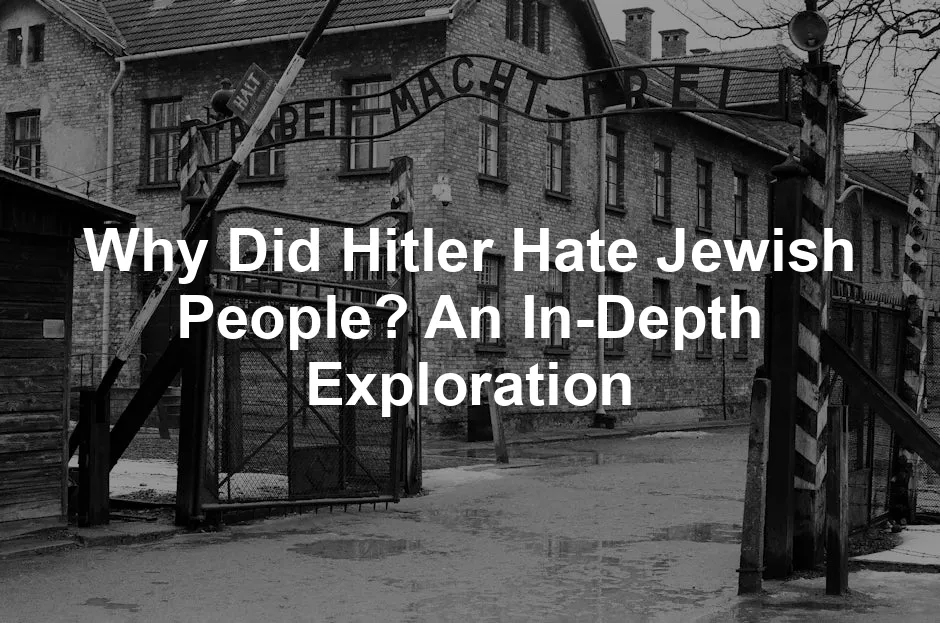
Why Did Hitler Hate Jewish People? An In-Depth Exploration
Introduction
Adolf Hitler’s hatred of Jewish people is a crucial topic. Understanding this animosity helps us grasp the horrific events of the Holocaust. His actions led to the loss of millions of lives and marked a dark chapter in history. Recognizing the root causes of Hitler’s antisemitism is essential for preventing future atrocities.
Summary and Overview
This article will examine several key themes surrounding Hitler’s hatred of Jews. First, we’ll explore the historical context of antisemitism in Europe. This backdrop set the stage for Hitler’s rise. Next, personal influences on Hitler during his early life will be analyzed. His upbringing in Austria exposed him to prevalent antisemitic sentiments.
Additionally, we’ll consider the sociopolitical environment following World War I. Economic instability and national humiliation fueled extremist ideologies. We’ll connect these factors to the broader rise of antisemitism that culminated in the Holocaust. Understanding these elements is vital. It not only sheds light on a painful past but also helps us combat hatred today.

If you’re looking to deepen your understanding of the Holocaust, consider reading “The Holocaust: A New History” by Laurence Rees. This insightful book offers a comprehensive look at the events and ideologies that shaped this tragic period.
Historical Context of Antisemitism
The Long History of Antisemitism
Antisemitism in Europe has deep roots. It began in the Middle Ages, primarily driven by religious differences. Early Christians viewed Judaism as a deviation from their faith. This led to forced conversions and violent persecution. Economic factors also played a role; Jews were often scapegoated during financial crises. They faced restrictions in professions, which fueled resentment.
Significant events like the Crusades and the Inquisition intensified antisemitic sentiments. Jews were falsely accused of crimes, such as well poisoning during the Black Death. By the 19th century, racial theories emerged, portraying Jews as a distinct and inferior race. This historical backdrop shaped a culture of hatred that Hitler later exploited for his agenda.

Hitler’s Early Life and Influences
Adolf Hitler was born in Austria in 1889. His upbringing in Linz and later in Vienna exposed him to a strong antisemitic atmosphere. Vienna was home to various political movements that propagated hatred towards Jews. Hitler’s family background was mixed; his father was authoritarian, while his mother was protective. This dynamic influenced his views on authority and identity.
Hitler aspired to be an artist but failed to gain admission to art school in Vienna. His frustrations may have fueled resentment towards successful Jewish artists, who he perceived as rivals. During this period, he encountered Jewish individuals, but his views hadn’t fully formed yet. However, the seeds of antisemitism planted in his early years would grow into a toxic ideology that would have devastating consequences.
To truly grasp the emotional weight of this history, consider reading “The Diary of a Young Girl” by Anne Frank. This poignant account from a young Jewish girl hiding during the war offers a deeply personal perspective on the impact of hatred and persecution.

The Impact of World War I
The Stab-in-the-Back Myth
After World War I, a damaging myth emerged in Germany. Many believed Jews were responsible for the country’s defeat. This idea became known as the “stab-in-the-back” myth. Soldiers returning home, including Hitler, felt betrayed. They struggled to understand how Germany could lose a war they believed was going well.
This myth gained traction through war propaganda. Political factions used it to shift blame and rally support. The narrative painted Jews as traitors. It suggested that Jews and left-wing groups had undermined the war effort. This scapegoating intensified societal resentment towards Jews. It also provided a convenient enemy for those seeking to explain Germany’s hardships.

For a gripping insight into the psychological aftermath of the war, consider reading “Man’s Search for Meaning” by Viktor E. Frankl. This powerful memoir reflects on finding purpose amidst suffering, a theme that resonates deeply in the context of post-war Germany.
Post-War Socioeconomic Turmoil
The aftermath of World War I left Germany in chaos. The Treaty of Versailles imposed harsh penalties. Economic instability followed, with hyperinflation and massive unemployment. This turmoil created a breeding ground for extremist ideologies.
Hitler capitalized on this discontent. He presented himself as a savior, promising to restore Germany’s pride and economy. His antisemitic rhetoric resonated with many desperate citizens. By blaming Jews for the country’s woes, he solidified their role as scapegoats. This narrative gained momentum during the political polarization of the 1920s and early 1930s.

If you want to explore the heartbreaking stories of those who suffered during this time, “Night” by Elie Wiesel is a must-read. This harrowing account of Wiesel’s experiences in the concentration camps powerfully illustrates the depths of human despair.
Hitler’s Ideology and Antisemitism
Racial Theories and Social Darwinism
Hitler’s beliefs about racial superiority were deeply rooted in pseudoscience. He viewed the Aryan race as the pinnacle of humanity. This belief led him to see Jews as racially inferior and a threat. Such views weren’t unique to Hitler; they were part of contemporary racial theories that gained traction in Europe.
Social Darwinism influenced many in this era. It applied Darwin’s ideas of natural selection to human societies. This twisted understanding justified discrimination and violence against those seen as “weaker.” For Hitler, the struggle for survival meant purging those he deemed inferior. His ideology rationalized horrific actions, laying the groundwork for systemic persecution.

To further understand how propaganda influenced public perception, check out “Eichmann in Jerusalem” by Hannah Arendt. This book explores the nature of evil and the mechanisms that allowed for the Holocaust to occur.
Propaganda and the Scapegoating of Jews
Nazi propaganda played a vital role in shaping public opinion. It systematically dehumanized Jews, portraying them as the enemy. The regime used media manipulation effectively, spreading antisemitic messages across Germany. Public rallies became platforms for amplifying hatred, often filled with incendiary speeches.
One key event was the 1936 Berlin Olympics. While the world watched, the Nazis promoted a false image of a harmonious society. Yet, antisemitic propaganda continued behind the scenes. Campaigns portrayed Jews as responsible for Germany’s struggles, fueling resentment. This scapegoating turned many ordinary citizens against their Jewish neighbors, laying the foundation for widespread violence.

For a deeper dive into the societal impacts of the Holocaust, consider “The Destruction of the European Jews” by Raul Hilberg. This seminal work meticulously documents the Holocaust and its implications.
The Escalation to the Holocaust
From Discrimination to Violence
The path to the Holocaust began with legal discrimination. The Nuremberg Laws, enacted in 1935, stripped Jews of their citizenship and rights. These laws marked a shift from social exclusion to systematic oppression. Jews faced increasing isolation, barred from professions and public life.
This climate of hate escalated into violence. Kristallnacht, or the Night of Broken Glass, in 1938, stands as a key turning point. During this pogrom, Jewish homes and businesses were attacked. Synagogues were burned, and thousands were arrested. The violence was state-sanctioned, showing a chilling commitment to antisemitic policies. This marked a dark escalation, laying the groundwork for more horrific actions to come.

To visualize the human stories behind these events, consider watching “Schindler’s List” (DVD). This powerful film portrays the true story of Oskar Schindler, who saved hundreds of Jews during the Holocaust.
The Final Solution
The Holocaust represented the systematic extermination of Jews, a chilling chapter in history. The Nazi regime implemented the “Final Solution,” a plan to annihilate the Jewish population of Europe. This policy was formalized at the Wannsee Conference in 1942.
Concentration camps became instruments of mass murder. Places like Auschwitz turned into sites of horror, where millions were killed. Einsatzgruppen, mobile killing units, executed Jews en masse in occupied territories. These brutal tactics demonstrated a chilling efficiency in carrying out genocide. The Final Solution wasn’t just a plan; it was a horrific reality that claimed six million innocent lives. Understanding this systematic approach is vital to remembering the atrocities of the Holocaust.

For another perspective on survival during this dark time, consider reading “Survival in Auschwitz” by Primo Levi. This memoir recounts the harrowing experiences of a Holocaust survivor, shedding light on the resilience of the human spirit.
Conclusion
Hitler’s hatred of Jews stemmed from a complex mix of personal experiences, societal influences, and historical prejudices. The progression from legal discrimination to violent persecution illustrates how deeply ingrained antisemitism can escalate. Remembering this history is crucial. It helps combat antisemitism today and prevents future atrocities. Continued education and awareness are vital tools in this ongoing effort.
For a deeper understanding of the origins of Hitler’s hatred, you can explore why did hitler hate jews.

Additionally, if you’re interested in a broader understanding of the Holocaust, consider watching “The Holocaust: A History” by Doris L. Bergen. This book provides a comprehensive overview of the Holocaust and its implications on modern society.
Please let us know what you think about our content by leaving a comment down below!
Thank you for reading till here 🙂
All images from Pexels




